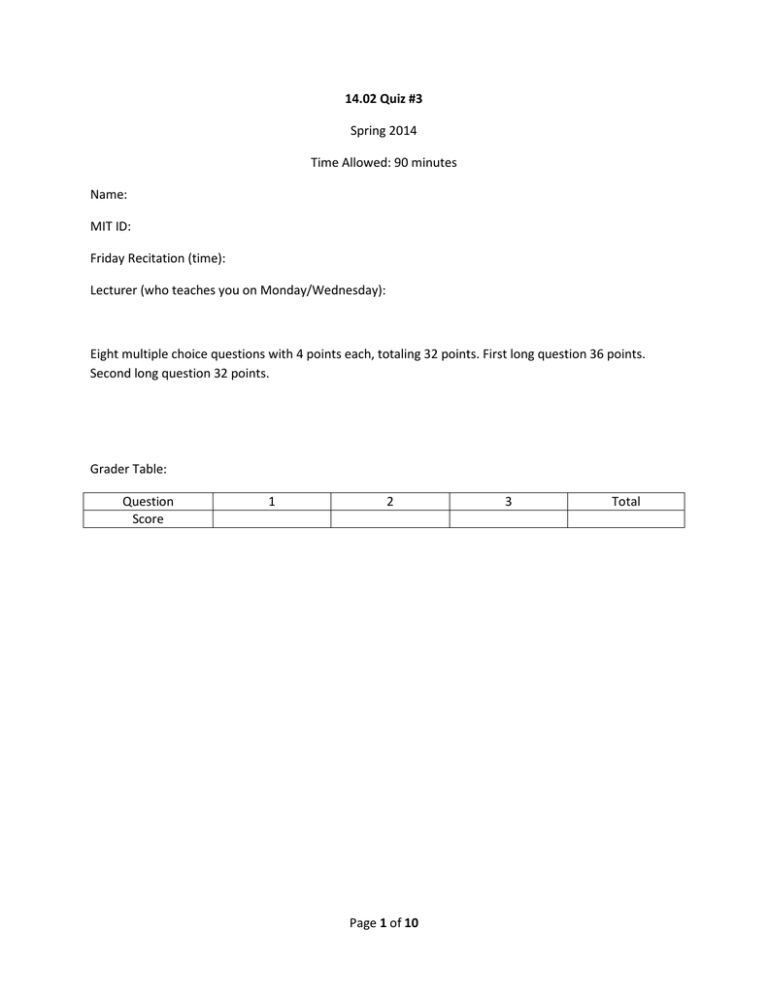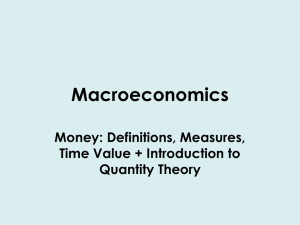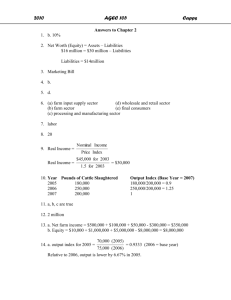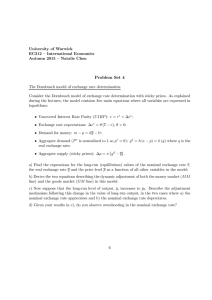Spring 2014 Time Allowed: 90 minutes Name: MIT ID:
advertisement

14.02 Quiz #3 Spring 2014 Time Allowed: 90 minutes Name: MIT ID: Friday Recitation (time): Lecturer (who teaches you on Monday/Wednesday): Eight multiple choice questions with 4 points each, totaling 32 points. First long question 36 points. Second long question 32 points. Grader Table: Question Score 1 2 Page 1 of 10 3 Total 1. Multiple Choice: Total 32 points (4 points each) 1) Consider an Open Economy with Flexible Exchange Rate. Assume price and expected price are fixed. What happens to Net Export after a decrease in nominal money supply? a. Increase b. Decrease c. Unchanged d. Indeterminate The answer is D. Price is fixed so a decrease in nominal money supply translate to decrease in real money supply. There is a southeast shift in LM, intersecting IS at a i) lower interest rate and ii) higher output. Both of these affects net export in different directions, so ultimately the change in net export is indeterminate. The output channel is straightforward through increase in import. The interest rate channel is more complicated. For UIP to hold, nominal exchange rate must decrease with interest rate. With price fixed, this translate to decrease in real exchange rate, and ultimately increase net export through Marshall Lerner condition. Note that even though we do not assume Marshall Lerner condition, the answer is the same as one of the channel is indeterminate. 2) Consider an Open Economy with Fixed Exchange Rate. What is the accompanying movement in IS/LM when AS shifts. Assume that AD is downward sloping and does not shift. a. IS shift b. LM shift c. Both a. and b. d. Neither a. nor b. The answer is C. Shift in AS result in a change in price. Price affects LM through change in real money supply. This is the same channel we studied in the closed economy. In the open economy, IS is also affected. Change in price affects real exchange rate, which in turn affects net export. 3) Consider a Closed Open Economy with Fixed Exchange Rate. The interest rate is initially at the world interest rate. There is a devaluation. Assume investors do not expect any further devaluation or revaluation. What happens to the interest rate? a. Increase b. Decrease c. Unchanged d. Indeterminate The answer is C. Because the currency is not expected to devalue nor revalue, UIP imply that domestic interest rate equals world interest rate. Since the same is true prior to devaluation, there is no change interest rate. The Devaluation came as a surprise. Page 2 of 10 In an earlier version of the test, the question ask about Closed economy, The answer is still the same; exchange rate does not enter either the IS or LM, so there is no effect on interest rate. 4) Assume that consumers wish to smooth consumption over time. Let Ricardian Equivalence hold. How does current consumption respond to an increase in government spending? a. Increase b. Decrease c. Unchanged d. Indeterminate 1.4 The answer is D. A situation where it could increase is covered pset 5#2. The situation where it could decrease is covered in recitation on April 25th (capacity constraint model). 5) Which of the following would contribute towards an increase in debt/output ratio, all other things equal. Assume that nominal interest rate is fixed and there is no Seigniorage. a. Slower Inflation b. Faster Real Output Growth c. Decreased Government Spending d. None of the Above The answer is A. Given that nominal interest rate is fixed, slower inflation translate to larger real interest rate. This makes debt, which appears in the numerator, grow faster. B is wrong as it specify that the denominator grow faster. C is wrong because decreased government spending reduces debt. 6) In a particular year, Nominal government spending equals Nominal taxes. Over the course of the year, Real public debt increases by 3% while Nominal public debt increases by 4%. What is the implied inflation rate? Round your answer to closest digit. a. 0% b. 1% c. 4% d. Not enough information The answer is B. Given zero primary deficit (Spending=Tax), real debt grows at the rate of real interest rate (3%). Correspondingly nominal debt grows at the rate of nominal interest rate (4%). 1 + 𝜋 = (1 + 𝑖)/(1 + 𝑟). Rounding the answer gives 1%. Alternatively you can use the linear approximation 𝜋 = 𝑖 + 𝑟 which also gives 1%. 7) In each period 𝑡, the central bank chooses 𝜋𝑡 and 𝑌𝑡 to minimize the following loss function 𝐿𝑡 = (𝜋𝑡 − 𝜋 ∗ )2 + (𝑌𝑡 − 𝑌 ∗ )2 Assume that 𝜋 ∗ > 0 and 𝑌 ∗ = 𝑌𝑛 (the natural level). The Phillips’ Curve follows the version seen in class with a linear relationship between 𝜋𝑡 and 𝑌𝑡 . The private sector expects 𝜋 𝑒 = 𝜋𝑡−1 . At 𝑡 = 0, 𝜋0 < 𝜋 ∗ , and 𝑌=𝑌𝑛 . Describe the evolution of output from 𝑡 = 1 onwards. (Hint: you might want to solve the second long question before tackling this) a. Output remains at natural level for all 𝑡 ≥ 1 Page 3 of 10 b. Output increases at 𝑡 = 1 and remains at that level c. Output increases at 𝑡 = 1 and returns to 𝑦𝑛 at 𝑡 = 2, then remains there d. Output increases at 𝑡 = 1 and gradually returns to natural level The answer is D. Consider 𝑡 = 1. Because 𝜋1𝑒 = 𝜋0 > 𝜋 ∗ , the Phillips curve lies below the the desired point (𝜋 ∗ , 𝑌𝑛 ). As such, the global minimum cannot be achieved. Central bank is constrained to choose a point on the Phillips’ Curve. Because central bank values both inflation and output, it will choose 𝜋1𝑒 < 𝜋1 < 𝜋 ∗ and 𝑌1 > 𝑌𝑛 . 𝜋1𝑒 < 𝜋1 = 𝜋2𝑒 so Phillips Curve shift upward at t=2 compare to t=1 but 𝜋 ∗ > 𝜋1 = 𝜋2𝑒 , so it still lies below the desired point. We are back at a similar situation to t=1, so applying the argument above we can get 𝑌2 > 𝑌𝑛 . But note that Phillips curve is now closer to bliss point so 𝑌2 < 𝑌1 . Combine the inequalities to get 𝑌1 > 𝑌2 > 𝑌𝑛 . Iterate to get 𝑌2 > 𝑌3 > 𝑌𝑛 . So the correct answer is D. 8) Which of the following is NOT consistent with the events leading up to the recent financial crisis. a. Increasing Leverage b. Increasing House Price c. Decreasing Equity d. Increasing Debt The answer is C. This is simply the observed fact as presented in class. House Price, Leverage, Equity, and Debt all increases in the period before the financial crisis. Anticipating that house prices will further increase, Bank are lax in approving loan, allowing mortgage with high leverage. This in turn increase demand for housing which further increases price. Equity increase with housing value, while debt increase with leverage. Page 4 of 10 2. Long Question: IS/LM-AS/AD in open economy. Total 36 points Consider the open economy IS/LM-AS/AD model covered in class. You may find it useful to draw out these graphs in answering the questions, but they are not necessary for the solution. 𝑰𝑺: 𝒀 = 𝑪(𝒀 − 𝑻) + 𝑰(𝒀, 𝒊) + 𝑮 + 𝑵𝑿(𝒀, 𝒀∗ , ε) 𝑳𝑴: 𝑴𝒔 /𝑷 = 𝑴𝒅 (𝒊, 𝒀) 𝑨𝑺: 𝑷 = 𝑷𝒆 𝑭(𝒖, 𝒛)[𝟏 + 𝒎] Output 𝒀𝟎 is initially at the natural level 𝒀𝒏 , and the initial nominal interest rate 𝒊𝟎 equals the world nominal interest rate 𝒊∗ . Assume that i) the government does not implement any other policy than what is stated; ii) there is perfect capital mobility; iii) the Marshall-Lerner condition holds; iv) the government is currently operating a flexible exchange rate regime. a. State the Uncovered Interest Parity Condition. Does this condition hold? (6 points) 𝑒 (1 + 𝑖) = (1 + 𝑖 ∗ )𝐸𝑡 /𝐸𝑡+1 . This equation generally holds in Open Economy, but specifically hold here because it is explicitly assumed that there is perfect capital mobility. Consider an increase in Government Spending ∆𝑮 > 𝟎. For now, analyze the economy in the short run (both price and expected price are fixed) b. Denote E 𝑆 the nominal exchange rate resulting from short run adjustment. How does E 𝑆 compare to the initial exchange rate E 0 ? (6 points) 𝐸 𝑆 > 𝐸 0 . ∆𝐺 > 0 shifts IS northeast, resulting in higher output and interest rate. For UIP to hold, nominal exchange rate must also increase. Page 5 of 10 Now, analyze the economy in the medium run c. State the equation governing the relationship between real exchange rate ε and nominal exchange rate E. In the context of the given model, classify the variables in this equation as either endogenous or exogenous. (6 points) 𝜀= 𝐸𝑃 . 𝑃∗ Only foreign price is exogenous. Domestic price is endogenous because in the medium run price is not fixed. Nominal Exchange rate is endogenous because it depends on nominal interest rate through the UIP. d. Denote ε𝑀 the real exchange rate resulting from medium run adjustment; and denote ε𝑆 the real exchange rate resulting from short run adjustment. How does ε𝑀 compare to ε𝑆 ? To receive full credit, you must account for changes in all endogenous variable listed in part c (6 points). 𝜀 𝑀 > 𝜀 𝑆 . Domestic price increase, while nominal exchange rate is indeterminate. However, price channel will always dominate. Proof by contradiction. Assume 𝜀 𝑀 ≤ 𝜀 𝑆 . This lead to increase in Net Export, shifting IS northeast. At the transition to medium run, has price increasing, which shift LM northwest. These two effect both increase nominal interest rate. For UIP to hold, nominal Exchange Rate must also increase. With increasing price, real exchange rate increases. But this is a contradiction. Page 6 of 10 The economy now arrives at the medium run equilibrium described above. The Government, having faced volatility in nominal exchange rate, decides to fix the nominal exchange rate at the current floating rate. It makes a public announcement which convinces investors that it will defend this nominal exchange rate indefinitely. Consistent with this announcement, it implements the necessary policy to fix the nominal exchange rate. Analyze the economy in the short run (both price and expected price are fixed) e. Denote Y 𝐹 the output level resulting from short run adjustment after the government implements the necessary policy to fix the nominal exchange rate. How does Y 𝐹 compare with the initial output level 𝑌 0 ? (hint: how does 𝑖 𝑀 compare with 𝑖 0 ?) (6 points) 𝑌 𝐹 > 𝑌 𝑛 = 𝑌 0 . From the hint and medium run analysis you should figure out that 𝑖 𝑀 > 𝑖 0 = 𝑖 ∗ . The 𝑒 announcement ensures that 𝐸𝑡 = 𝐸𝑡+1 . As such UIP does not hold. In particular, there is net capital inflow, which puts upward pressure on exchange rate. To make UIP hold, interest rate must decrease. In IS/LM this can be achieved by either shifting IS southwest, or LM southeast. However, only the latter is fast enough to defend the currency. As such government increases real money supply, which increases output above natural level. f. Outline a situation where a different expectation could cause output to move in a different direction than in part e. (6 points) 𝑒 If instead the currency is expected to devalue 𝐸𝑡 > 𝐸𝑡+1 , then interest rate according to UIP will be 𝑒 ∗ higher than 𝑖 . In fact if 𝐸𝑡 ≫ 𝐸𝑡+1 , then this rate will be higher than 𝑖 𝑀 . In that case, government would instead need to increase interest rate. This will be done through a reduction in real money supply, which reduces output. Page 7 of 10 3. Long Question: Monetary Policy with Positive Optimal Inflation. Total 32 points Consider a central bank choosing inflation 𝝅𝒕 and output 𝒀𝒕 to minimize the following loss function. Assume that 𝝅∗ > 𝟎 and 𝒀∗ = 𝒀𝒏 . 𝑳𝒕 = (𝝅𝒕 − 𝝅∗ )𝟐 + (𝒀𝒕 − 𝒀∗ )𝟐 The Aggregate Supply Curve has the following form. (You may assume that both the monopoly markup variable 𝒎 and catchall variable 𝒛 are small.) 𝑷𝒕 = 𝑷𝒆𝒕 𝒆 𝒛−𝜶𝒖𝒕 [𝟏 + 𝒎] Output 𝒀𝒕 equals employed labor 𝑵𝒕 . Assume that total labor force 𝑨 is exogenous. 𝒀𝒕 = 𝑵𝒕 a. Solve for the natural level of output 𝑌𝑛 in term of the constant variables. How does 𝑌𝑛 vary with total labor force 𝐴? (4 points) First off, natural rate/level occur when 𝑃𝑡 = 𝑃𝑡𝑒 . This simplify the equation to 1 = 𝑒 Solve for 𝑢𝑡 to get 𝑢𝑛 = 𝑙𝑛[1+𝑚]+𝑧. 𝛼 𝑧−𝛼𝑢𝑛 [1 + 𝑚]. From the definition of unemployment, we get 𝑌𝑛 = 𝑁𝑛 = (1 − 𝑢𝑛 )𝐴 𝑌𝑛 = �1 − 𝑙𝑛[1 + 𝑚] + 𝑧. �𝐴 𝛼 𝑌𝑛 = �1 − 𝑚 + 𝑧. �𝐴 𝛼 You may choose to further log-linearize the expression. But either answer will receive full marks. b. State a reason why 𝜋 ∗ > 0 is a realistic feature. On the other hand, give a reason why inflation should not be too high. (6 points) 𝜋 ∗ > 0 is good for combating i) Liquidity trap; and ii) Nominal rigidity. However very large 𝜋 is bad because of i) menu cost; ii) shoeleather cost; iii) price signal distortion; iv) hurt debt holders; v) tax distortion; iv) inconvenience of moving around large amount of money (e.g. Germany). You only need to state one reason each to receive full marks Page 8 of 10 c. Assume for this part that 𝜋𝑡𝑒 is exogenous. Draw the Phillips’ Curve relationship between output level 𝑌𝑡 and the inflation rate 𝜋𝑡 . Be explicit about the slope and intercept. (4 points) Note that since 𝜋𝑡 does not appear in the AS, we will first have to transform it into the Phillips Curve 𝑃𝑡 = 𝑃𝑡𝑒 𝑒 𝑧−𝛼𝑢𝑡 [1 + 𝑚] 𝑙𝑛(𝑃𝑡 ) = 𝑙𝑛(𝑃𝑡𝑒 ) + 𝑧 − 𝛼𝑢𝑡 + 𝑙𝑛[1 + 𝑚] 𝑙𝑛(𝑃𝑡 ) − 𝑙𝑛(𝑃𝑡−1 ) = 𝑙𝑛(𝑃𝑡𝑒 ) − 𝑙𝑛(𝑃𝑡−1 ) + 𝑧 − 𝛼𝑢𝑡 + 𝑙𝑛[1 + 𝑚] 𝑙𝑛(𝑃𝑡 /𝑃𝑡−1 ) = 𝑙𝑛(𝑃𝑡𝑒 /𝑃𝑡−1 ) − 𝑙𝑛(𝑃𝑡−1 ) + 𝑧 − 𝛼𝑢𝑡 + 𝑙𝑛[1 + 𝑚] 𝜋𝑡 = 𝜋𝑡𝑒 + 𝑧 − 𝛼𝑢𝑡 + 𝑚 The last step uses log-linearization. Next we convert 𝑢𝑡 to 𝑌𝑡 𝑌𝑡 = 𝑁𝑡 = (1 − 𝑢𝑡 )𝐴 𝑌 𝐴 → 𝑢𝑡 =(1 − 𝑡 ) + → 𝜋𝑡 = 𝜋𝑡𝑒 − 𝛼(1 − → 𝜋𝑡 = 𝜋𝑡𝑒 + 𝑌𝑡 𝑚 + 𝑧. − ) 𝐴 𝛼 𝛼 (𝑌 − 𝑌𝑛 ) 𝐴 𝑡 The last step uses the 𝑌𝑛 you solve in part a. From this equation it should be clear what are the slopes and intercepts. d. Assume that the private sector expects 𝜋𝑡𝑒 = 0, and the central bank internalizes this expectation. What inflation and output level does the central bank choose? To receive full credit, you must solve for the exact values. (6 points) The problem should be setup as 𝑚𝑖𝑛 𝐿 = (𝜋𝑡 − 𝜋 ∗ )2 + (𝑌𝑡 − 𝑌𝑛 )2 constrained by 𝜋𝑡 = (𝛼/𝐴)(𝑌𝑡 − 𝑌𝑛 ). 𝜋𝑡 𝐴 2 � . 𝛼 This simplify to 𝑚𝑖𝑛 𝐿 = (𝜋𝑡 − 𝜋 ∗ )2 + � The solution is 𝜋𝑡 = 𝛼𝜋 ∗ /(𝐴 + 𝛼); 𝑌𝑡 = 𝑌𝑛 + 𝐴𝜋 ∗ /(𝐴 + 𝛼). Page 9 of 10 Consider instead the following loss function 𝐿𝑡 = (𝜋𝑡 − 𝜋 ∗ )2 − 𝑌𝑡 e. Comment on why this loss function could be more realistic (compared to the other loss function). How does your answer in part d change with this new loss function? For this part, you do not need to solve the exact value of inflation and output. Stating how inflation and output compare to part d will suffice. (6 points) First off, with this new loss function, both output and inflation is higher compared to d. This is because with the new loss function, output beyond the natural level reduces loss, instead of increasing it. Regarding whether the new loss function is more realistic, the answer is open-ended. You can argue that the new loss function is more realistic, or conversely argue that the previous loss function is more realistic. As long as you display that you understand the (different) role of 𝑌𝑡 in both loss function, you will receive full marks. 𝐿𝑡 = (𝜋𝑡 − 𝜋 ∗ )2 + (𝑌𝑡 − 𝑌 ∗ )2 indicates that there is an optimal output 𝑌 ∗ . Increasing output beyond this value actually hurts the economy. With 𝐿𝑡 = (𝜋𝑡 − 𝜋 ∗ )2 − 𝑌𝑡 , more output is always better. f. Assume that the private sector instead expects 𝜋𝑡𝑒 = 𝜋𝑡 , and the central bank internalizes this expectation. What inflation and output level does the central bank choose? To receive full credit, you must solve for the exact values. Does it matter which loss function you minimize? (6 points) With endogenous expectation, Phillips Curve is now vertical. The central bank can no longer choose output because it is constant at the natural rate. With this in mind, see that the two loss functions are only different to a constant, which does not affect the minimization problem. Central bank solves With the obvious solution 𝜋𝑡 = 𝜋 ∗ min 𝐿 = (𝜋𝑡 − 𝜋 ∗ )2 Page 10 of 10 MIT OpenCourseWare http://ocw.mit.edu 14.02 Principles of Macroeconomics Spring 2014 For information about citing these materials or our Terms of Use, visit: http://ocw.mit.edu/terms.







